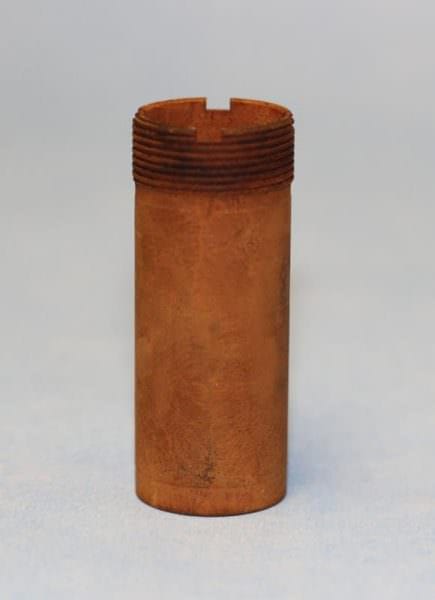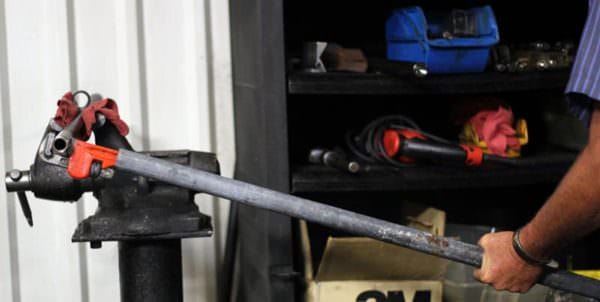

You eventually end up putting enough torque on the wrench that it causes your face to turn red and your arms too start to tremble. The choke still does not move. You then find some sort of tool to give you additional leverage on the wrench and the darn choke tube still refuses to budge.
You start to wonder what you did to cause this problem!
There are basically three things that will freeze shotgun chokes in the barrel:
- Rust
- Residue build up from fired shells (unburned powder, fiber, plastic, etc.)
- Choke tube expansion (Creep)
If you want to keep your shotgun chokes functioning as they were intended then the below maintenance items should be followed on a regular basis.
- Loosen and retighten the choke on occasion. Even better if you remove the choke and reinstall in the barrel on a regular basis. This will break any bond that is attempting to form.
- Clean the choke body and remove residue from the threads with a stiff brush and solvent of some kind.
- Clean the internal threads and choke counterbore in the barrel using a bronze bore brush and solvent.
- Wipe all surfaces dry after cleaning and lubricate them with a few drops of high quality gun oil.

Choke tubes like this are what you are trying to avoid.

This is not how you want to remove a choke tube.
Stuck Choke Tube’s From the Use of Steel Shot:
Choke tubes frozen in place from expansion is different from rust or residue build up. However rust, residue build up and choke expansion can all occur at the same time.
Without getting to deeply involved in the science of metals you need to know that when a shot charge passes through a choke tube it exerts a force in two different directions. Force is applied to the choke tube when the shot charge strikes the choke forcing cone.
The first direction is longitudinal. The force in this direction simply tries to push the choke out of the barrel. This is prevented from happening by the interlocked threads on both the choke and the internal threads of the barrel. If enough force is exerted then the threads in the barrel and or the threads on the choke shear and out it goes. I have never seen a choke fail from thread shear.
The second direction is at approximately right angles to the bore. In this direction the applied force tries to make the choke expand. As the shot column moves through the choke tube forcing cone, the pellets are in constant movement to rearrange themselves so that the shot column becomes smaller in diameter and elongated. This generates a force that wants to expand the choke tube.
- Steel is elastic to some degree.
- If enough force is applied the choke tube will expand by a small amount and when the force is removed it will contract to its original size and shape.
- One of the ways we measure the strength of steel is by “Yield Strength”.
- For our purpose we can define yield strength as the maximum amount of force that is applied that does not cause any permanent deformation of the steel.
- If we increase the level of force past the yield strength of the steel used in that choke, it will expand past its elastic limit and stay in this expanded size.
- If you continue to shoot this load in this choke tube it will expand a small amount each time and at some point it will be solidly locked into the barrel.
- This force reaches its peak nominally at the intersection of the choke forcing cone and the parallel section. This is the area where choke expansion will occur.
- Choke tubes in this condition cannot be removed by normal methods.
The actual force is generated from a number of combined factors:
- Size of steel shot- The larger the diameter of the shot the more force is created
- Weight of the shot charge- Heavier payloads cause higher forces
- Choke constriction- More constriction causes higher forces
- Velocity- the higher the velocity the more force is created
Very high velocity steel shot shells with large diameter (particularly size B and larger pellets) through tighter (typically full or tighter) constriction chokes are usually the culprit causing choke expansion.
One of the best ways to prevent choke expansion is to follow the choke manufacturer’s recommendations:
- Some choke manufacturers will mark the choke “no steel” if it is not rated for steel.
- Some mark the choke “approved for steel”
- All factory chokes, as a rule, are rated for steel shot loads from cylinder bore through modified constriction, at least all that I have seen.
- If you use a factory choke tighter than modified that is not marked for use with steel, I would check it on a regular basis for choke expansion.
- If you find a choke tube that gets progressively harder to remove and replace each time you do so, examine it carefully as it is probably failing from expansion.
- If in doubt whether a choke is rated for steel, contact the manufacturer
In my experience with steel shot I have found that if a choke does not expand with a given steel load after 25 shots it will never expand. Don’t take that as a fact as nothing is 100 percent when it comes to shotguns. However to date, this rule of thumb has never failed me.
While this is certainly not intended to be a true technical paper, hopefully it has given you a basic understanding of why choke tubes can and do freeze in the barrel.
About Trulock Chokes:
The staff at Trulock Chokes prides itself on providing excellent service and an excellent line of products. In the event you are not completely satisfied with your purchase you can return it for a refund or exchange within 60 days from the date of purchase – with other firms, the moment you open it, you own it.
For more information, please visit their website.

If you run into this problem……….block the barrel with a rag below the choke tube about 4 inches………spray PB Blaster down the tube ……………wait ..spray again ………at least an hour ……….Get your buddy to hold the firearm and take the choke tube wrench and carefully start turning….you might have to use channel locks to remove the choke tube only after it has cleared the threads…..use a rag to prevent damage to choke tube while using the pliers and use just enough force to remove the tube……..then remind the owner of the gun this is why they make GUN CLEANING KITS………Hope… Read more »
Tetra Bore Conditioner is the best and simplest cure for this problem, apply it to a clean dry bore and choke threads, you’ll never be troubled again by rust or fouling. The only more sure method is a barrel with a fixed choke!
I’ve had good luck using high temp anti-seize on my choke tube threads. Still, I take the tube out every time I clean the weapon…and I’m in the “clean it after every use” crowd.
Me, too (not #metoo). Remove the choke each time you clean your gun, then clean and lightly lube the choke before you replace it.
And clean your gun after each use. If it will be stored for a long time, remove the chokes.
Excellent article.
Might a quality anti seize product help when properly applied?
Yes. I certainly use a lube specifically designed for choke tubes. I was surprised that the author only mentioned a bit of oil as being sufficient.. if that’s all you’ve got, then that’s all you’ve got, but the same place that sells the shotgun will also sell choke tube grease. . . .
It IS a good idea to remove the choke tube and give it and the barrel mating surfaces a good cleaning every 500 rounds, but I actually try to do that every 100 rounds if at all possible.